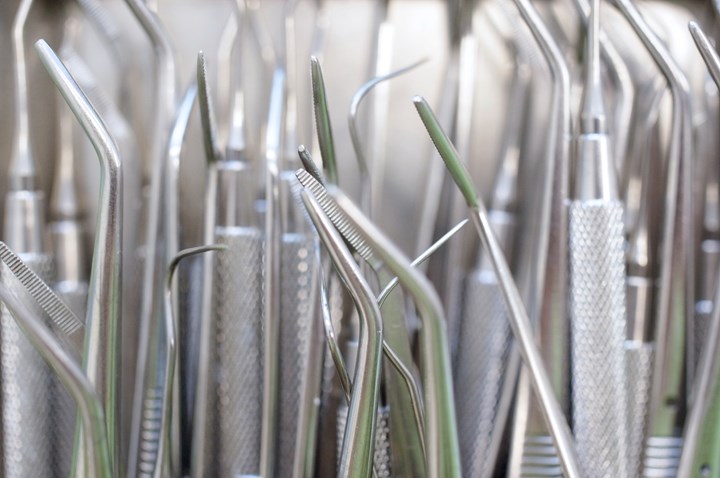
Medical devices can feature intricate shapes including hard-to-clean grooves, textures and knurling.
Photo Credit: All photos courtesy of MicroCare
As medical devices become increasingly compact, minimally invasive, and more efficient, manufacturing techniques are evolving to keep up with these highly complex designs.
Building new miniature devices, however, can be a challenge. Medical devices must be cleaned, dried and finished to the highest standards to ensure they are ready for the next step in the manufacturing process. Any remaining particulate or residue can lead to inconsistent outcomes impacting not only the devices’ performance, but also the validation process.
Manufacturers must be certain that production procedures, including finishing processes, have the necessary controls in place to produce products that satisfy quality and regulatory specifications.
Why is Cleaning So Important?
Medical devices can be complex assemblies that encompass intricate shapes and delicate materials, making cleaning during production particularly difficult. Despite those challenges, the requirement for the perfect finish is critical. Complete removal of production debris like machining, stamping or cooling oils, dust, metal filings, marking inks, fingerprints and other soils must be done prior to assembly, packaging, sterilization or coating.
The cleaning process should be suitable to remove the contamination and meet the exacting regulations and validation controls typically required of medical devices, especially those produced or assembled in a cleanroom environment. This, however, has become more difficult as the medical devices become increasingly smaller, incorporate tighter spaces and have deep blind holes or intricate openings that are particularly problematic to clean and dry.
There is also material compatibility to consider. Medical devices are made from a variety of materials, including metals, ceramics, polycarbonate and acrylic, so the cleaning method must not damage surfaces or delicate components.
To meet cleanliness standards and strict cleanroom validation criteria, the chosen cleaning process must also be consistent, easy-to-use and compatible with established procedures. Vapor degreaser cleaning is a well-engineered process that is simple, predictable and repeatable, making it easy to qualify for medical device manufacturing.

Vapor degreasers do not introduce outside contamination to a clean room.
Vapor Degreasing – the Benefits
Vapor degreasing is a closed-loop system containing two chambers, the boil sump and the rinse sump. The boil sump contains a specially-formulated low-boiling, non-flammable cleaning fluid. Parts are immersed and cleaned inside the heated fluid. Once cleaned, they are mechanically transferred to the rinse sump for final rinse and dry in more pure, uncontaminated fluid, or inside the fluid vapors themselves. As a result, the parts come out clean, dry, spot-free and immediately ready for the next step in the process, whether that is assembly, finishing, sterilizing or final packaging.
A vapor degreaser is easy to incorporate into a cleanroom since it doesn’t introduce outside contamination into the cleanroom. It also has a small footprint, especially compared to high volume aqueous cleaning machines, so it does not take up a lot of expensive cleanroom real estate.
Effective Cleaning
When used inside a vapor degreaser, modern cleaning fluids are specifically engineered to effectively clean and dry delicate medical device parts without damage. They feature unique low boiling temperatures, low surface tensions and low viscosities. These factors combine to completely dissolve contaminants and remove them with ease. The fluid easily penetrates and cleans very tight spaces and importantly, completely evaporates without leaving residue behind. Most vapor degreasing fluids are also heavy and dense. They are up to 40% heavier than water, helping them to lift and float solid particulate from the parts.
It is also possible to combine the vapor degreasing cleaning process with a second-step surface treatment for the application of medical-grade lubrication or a specialty film. This means the process of cleaning and coating can be completed quickly to streamline the overall finishing process.
Eliminate Bioburden
It is important to use cleaning processes that do not carry a bioburden risk. Trace amounts of water or water-based cleaners can allow the growth of bacteria and create related bioburden issues, compromising the ability to properly sterilize medical devices. Using modern solvent-based vapor degreasing cleaners eliminates this risk as it does not contain any water, ensuring a pyrogen-free cleaning environment.
Consistent Cleaning
Another benefit of a vapor degreaser is its consistency. Once established and tested, the cleaning fluid inside the vapor degreaser remains chemically stable for thousands of uses. Modern-day vapor degreasers require very little maintenance and most of the new cleaning fluids used inside will not require daily monitoring or acid acceptance testing. This helps ensure parts cleaning complies with any required process validation specifications.
Repeatable Results
Because vapor degreasers come in various sizes, they accommodate different needs. Whether it is small batch work where just a table-top version is required, or a mass-produced part where a machine that holds thousands of gallons of cleaning fluid is needed, the cleaning results always remain stable. Parts are cleaned using the same repeatable process. This means equipment additions or updates are rarely needed when new products are introduced to the vapor degreaser, even if they are a different size or are made from a different material.
Verified Results
Because the vapor degreasing process is consistent, it operates within established constraints which can be easily audited and documented for validation purposes. A complete cleaning record of the batch can be kept to demonstrate that all the steps defined by the procedures and instructions were undertaken and that the outcome was as expected.
The daily operation of a vapor degreaser is simple, and can oftentimes be automated. This simplifies worker training and ensures qualified personnel can always be available to carry out the parts cleaning procedures correctly.
Green Validation
Parts used within medical devices require not just long-term functionality, but they must also stand up to rigorous regulations put in place by governing bodies. For example, the Food and Drug Administration (FDA), which examines toxicity and sterility, and International Standards Organization (ISO) which identifies quality management processes.
Meeting sustainability requirements is also important. Cleaning fluids must comply with increasing environmental laws regulating cleaning fluid use and disposal. Growing numbers of regulatory agencies worldwide are increasing legislation and enforcing the laws to reduce any negative impact to workers or the planet.
Most modern vapor degreasing fluids have a zero Ozone Depleting Potential (ODP) and a low Global Warming Potential (GWP), reducing air quality concerns. They are also not a hazardous air pollutant (HAP) and do not require National Emission Standards for Hazardous Air Pollutants (NESHAP) permits.
Crossing the Finish Line
The very nature of medical devices is changing as they get smaller and more complex. Yet they must maintain their long-term performance and functionality at all times. Cleaning is an important step in ensuring parts are finished to the highest standards and meet strict regulatory, quality and reliability requirements.
Using modern cleaning fluids and vapor degreasing equipment not only provides effective and consistent cleaning, but also helps ensure environmental regulatory compliance as well as process validation.
When considering using vapor degreasing and modern-day cleaning fluids, look for a cleaning fluid supplier that can provide expert advice to simplify the selection process. This includes individualized consulting, access to lab testing, and a selection of compliant cleaning fluid options that include both off-the-shelf and customized formulations. This will ensure you get the right cleaning fluids and methods for your specific needs.
About the Author

Elizabeth Norwood
Elizabeth Norwood is a Senior Chemist at MicroCare LLC. Visit microcare.com.
Related Content
Alkaline Cleaning Guide
Gregg Sanko, Senior Chemist, Oakite Products, Inc. provides an overview of the alkaline cleaning process.
Read MoreTop Reasons to Switch to a Better Cleaning Fluid
Venesia Hurtubise from MicroCare says switching to the new modern cleaning fluids will have a positive impact on your cleaning process.
Read MorePretreatment of Black Oxide
Having issues achieving a consistent color with the application of black oxide? Start by looking at your pretreatment. Connor Callais of Hubbard-Hall offers advice for troubleshooting your black oxide process.
Read MoreTTX Environmental Solves Customer Issue with Electro-Ceramic Desalination Wastewater Processing
Electroplating facility without access to a drainage system found a safe solution for wastewater treatment and reuse.
Read MoreRead Next
Automation Smoothes the Way for Surgical Coatings
Medical device coating company discusses how automation enables increased abrasion resistance and improved insulative properties for electrosurgery.
Read MoreSolving Unmet Needs of the Medical Device Industry
Pioneer Metal Finishing's Medical Center of Excellence has expanded the company's capacity to serve the critical medical device industry. With ISO 13485 certification in hand, the company is now a key driver in medical innovations.
Read MoreThe Future of Virus Detection
High purity surfaces to enable spectroscopy-based diagnostic testing.
Read More






















